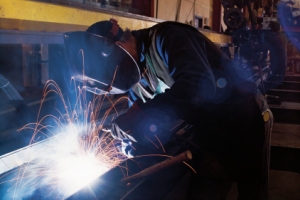 Welding, cutting, and brazing are hazardous activities that pose a unique combination of both safety and health risks to more than 500,000 workers in a wide variety of industries, according to federal OSHA.
Welding, cutting, and brazing are hazardous activities that pose a unique combination of both safety and health risks to more than 500,000 workers in a wide variety of industries, according to federal OSHA.
The risk from fatal injuries alone is more than four deaths per thousand workers over a working lifetime.
Welding, cutting, and brazing is addressed in specific OSHA standards for the general industry, shipyard employment, marine terminals, and construction industry.
One particularly serious hazard is welder exposure to hexavalent chromium [Cr(VI)], one of the valence states (+6) of the element chromium. It is usually produced by an industrial process. Cr(VI) is known to cause cancer. In addition, it targets the respiratory system, kidneys, liver, skin and eyes.
Chromium metal is added to alloy steel to increase hardenability and corrosion resistance.
A major source of worker exposure to Cr(VI) occurs during "hot work" such as welding on stainless steel and other alloy steels containing chromium metal. Cr(VI) compounds may be used as pigments in dyes, paints, inks, and plastics. It also may be used as an anticorrosive agent added to paints, primers, and other surface coatings. The Cr(VI) compound chromic acid is used to electroplate chromium onto metal parts to provide a decorative or protective coating.
Requirements to protect workers from Cr(VI) exposure are addressed in specific OSHA hexavalent chromium standards covering general industry (1910.1026), shipyards (1915.1026), and construction (1926.1126).
Who is exposed to hexavalent chromium?
It is estimated that 558,000 workers are potentially exposed to Cr(VI) in the United States. Workers in a variety of occupations are potentially exposed to Cr(VI). Workplace exposures occur mainly in the following areas:
- Welding and other types of "hot work" on stainless steel and other metals that contain chromium
- Use of pigments, spray paints and coatings
- Operating chrome plating baths
Where is exposure to hexavalent chromium occurring?
Industrial processes that involve chromium can result in worker exposure to toxic hexavalent chromium. OSHA provides a publicly available Chemical Exposure Health Database which includes industrial hygiene sample results from OSHA inspections. This database does not include worksite inspection sample results from many of the 26 States that operated OSHA-approved State Plans or OSHA consultation visits. This data provides a snapshot of industry sectors and business subcategories where levels of airborne Cr(VI) have been found. The industry profile tables in this website are based on Cr(VI) air samples taken during OSHA inspections from 2006 to 2009. While the tables represent only a small fraction of the total number of companies in their respective industries, the results can provide insight into where workplace Cr(VI) exposure is occurring in the United States.


